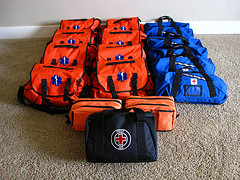What’s in your Travel Medical Kit?
27 July 2012
Some time ago, we recommended preparing for a personal medical emergency with a travel medical portfolio, but a new publication by Charles E. Davis, M.D., called The International Traveler’s Guide to Avoiding Infections (Johns Hopkins University Press) recently caught our eye.
In this book, Dr. Davis recommends travelers pack a travel medical kit appropriate for their trip. For example, what you take in your travel medical kit if you’re heading overseas for a month is different than what you’ll take when you’re going across state lines for a weekend getaway. It also depends on what type of trip you are taking.
Pack these in your travel medical kit as a minimum
These are the bare minimums travelers should carry in their travel medical kits:
- Prescription medications that are taken daily (in the original containers)
- Favorite over-the-counter meds needed for common maladies (headaches, indigestion, etc.)
- Antibiotics for preventing infection and antiseptic wipes
- Loperamide for self-treatment of traveler’s diarrhea
- Oral rehydration solution packs for treating severe dehydration
- Moleskin, bandages, triple antibacterial cream, and topical anti-fungal cream
- Digital thermometer (less easy to break during travel)
- Insect repellent (with 30-50% DEET)
- Sunscreen and sunburn treatment (like a gel with aloe vera)
- Basic medical info (more on that later)
- Disposable syringes, suture, and needle kit
That last item startled us too, but in some developing countries, sterilized medical supplies aren’t as commonly available as they are in the U.S.
As a result, needles and syringes are reused, which puts you at risk of contracting hepatitis B and C, HIV and other serious infections. Before heading to a foreign destination, visit a traveler’s medical clinic back home and request or buy a small sterile packet containing these items. If you are taken to a medical treatment facility on your trip, insist that those items are used.
What’s my basic medical info?
Consider being redundant about this particular bit, meaning you should have a few copies of this information for each traveler in your group: one in your suitcase, one in your money belt, and one in your travel medical kit.
- Name, phone number, and email address of your primary care physician and travel doctor
- Health insurance company name, identification number, and phone number
- Travel insurance company name, identification number, and phone number
- Names and dosages of each medication you are taking, including anti-malarials (copies of your prescriptions are a good idea because you may be able to get replacement medications if yours fall overboard on a river cruise, for instance)
- List of allergies and any current or chronic illnesses
- The address and phone number of a hospital or clinic you identified ahead of time that are within the vicinity of your travel destination
Come to think of it, it’s probably good to have this information in your wallet back home!
Pack these in your travel kit if you’re an adventurous traveler
In addition to those items listed as minimums, and depending on your trip, pack these items as well:
- If headed to remote areas where mosquito-borne disease are common, carry mosquito netting to sleep beneath. How do you know whether to pack this? Check the destination-specific current health reports from the CDC for information.
- If headed to a region where malaria is common, pack anti-malarial medications.
- If headed to a region where the tap water may not be pure, take water purification tablets or a water purification device. See Safe Drinking Water Tips for Travelers for details.
- If you’re a woman, consider taking medication for yeast infections, especially if you’ll be taking doxycycline for malaria.
- Benadryl and an epinephrine pen for severe allergic reactions to previously unencountered insect bites and stings
- Pain relievers and antacids
- Eye drops for dryness and eye drops to eye infections
- Latex gloves (to wear when treating wounds)
- Tweezers (for tick removal)
- Sterile bandages and scissors
- Antiseptic soap such as Betadine
- Butterfly closures and/or safety pins
A few more tips for safe travel
All of the above will help increase your chances of having a safe and enjoyable trip, and even make the difference for someone who is less prepared. The following are additional tips for a safe trip:
- Wear your medical bling – any bracelet or pendant you normally wear to indicate a medical condition should be worn while traveling too.
- Keep your prescription meds in their original containers. It’s tempting to put them into plastic zipper bags to save packing space, but if a security or customs agents suspects it might be something other than what it is, you could wind up in jail in some countries.
- Know that AIDS medications may cause you to be denied entry in some country. Plan ahead by finding out whether the area you are visiting has restrictions (St. Vincent and the Grenadines do). See the travel.state.gov site for country-specific entry requirements.
- Given the high number of HIV/AIDS and STD cases in some regions, carry and use condoms.
- Keep your travel medical kit with you in your carry-on. If your baggage goes missing, you may need it.
- Visit your doctor before you travel overseas or to a remote region of the world. See the Top Reasons to See Your Doctor Before You Travel for additional information.
See also
Damian Tysdal is the founder of CoverTrip, and is a licensed agent for travel insurance (MA 1883287). He believes travel insurance should be easier to understand, and started the first travel insurance blog in 2006.

